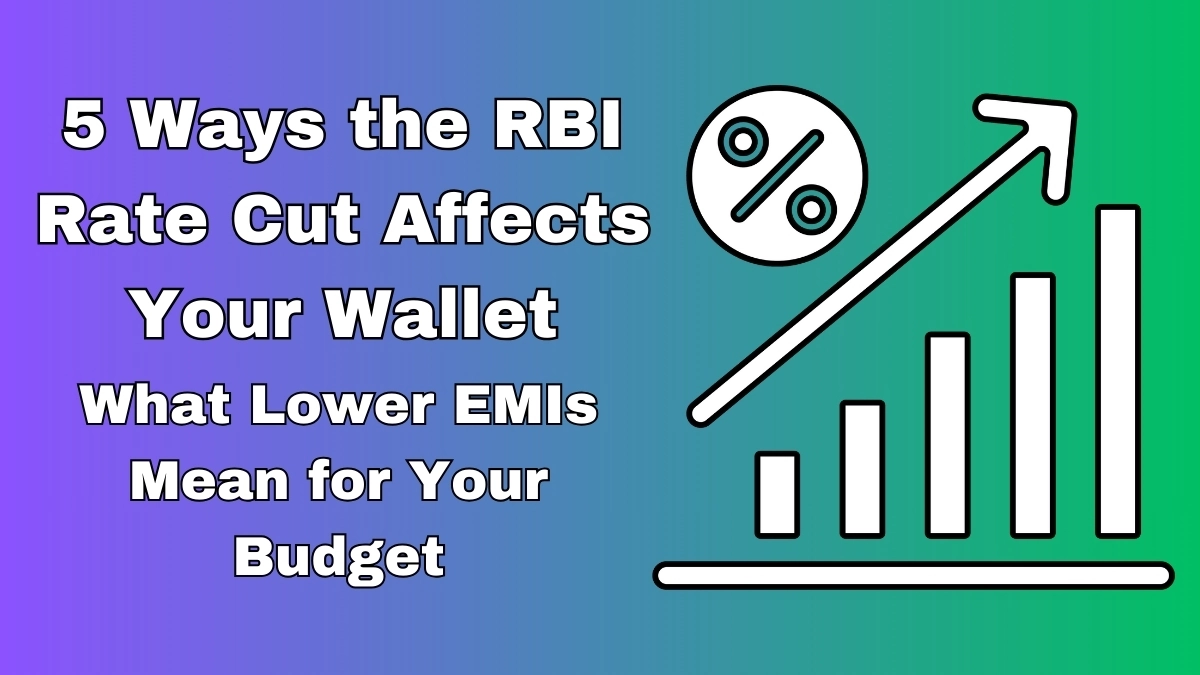The Reserve Bank of India (RBI) has reduced the repo rate by 25 basis points to 6.25%, marking the first rate cut in nearly five years. This decision, made by the Monetary Policy Committee (MPC) under the leadership of newly appointed Governor Sanjay Malhotra, aims to boost economic growth amid easing inflation and concerns over global risks. The rate cut is expected to lower borrowing costs for home loans and other credit facilities, potentially providing relief to millions of borrowers.
Table of Contents
Key Highlights of the RBI’s Decision
- Repo Rate Cut: The MPC has reduced the repo rate by 25 basis points, bringing it down to 6.25% from 6.5% .
- Unanimous Decision: The decision to cut the repo rate was unanimous among the six members of the MPC.
- Easing Inflation: The rate cut was influenced by easing inflation, which is expected to moderate further in FY26.
- Economic Growth: The move is intended to support GDP growth, which is projected to range between 6.3% and 6.8% in FY26.
- Global Risks: The MPC also considered global risks that could potentially slow down economic growth.
- Last Rate Cut: The last time the RBI reduced the repo rate was in May 2020, when it cut the rate by 40 basis points to support the economy during the pandemic.
Understanding the Repo Rate and its Impact
The repo rate is the interest rate at which the Reserve Bank of India (RBI) lends money to commercial banks. A cut in the repo rate generally leads to lower borrowing costs for banks, which, in turn, can reduce interest rates for consumers and businesses. This can lead to increased borrowing and spending, thereby stimulating economic activity.
Impact on Home Loans and EMIs
The repo rate cut is expected to have a direct impact on home loan borrowers. A 25 basis point reduction on a ₹1 crore home loan for 15 years will bring down EMIs by approximately ₹1,460 per month. Existing home loan borrowers with floating interest rates can expect their EMIs to decrease, while new borrowers may be able to avail of loans at lower interest rates.
Impact on the Economy
The RBI’s decision to cut the repo rate is aimed at boosting economic growth. By lowering borrowing costs, the central bank hopes to encourage investment and consumption, which are key drivers of economic activity. The rate cut is also expected to improve business sentiment and encourage companies to expand their operations.
Factors Influencing the RBI’s Decision
Several factors influenced the MPC’s decision to cut the repo rate:
- Inflation: Inflation has been declining in recent months, supported by a favorable food outlook and the continued transmission of past monetary policy actions. The MPC expects inflation to moderate further in FY26, gradually aligning with the target.
- Economic Growth: While the Indian economy is recovering, it remains below last year’s growth rate. The MPC believes that a rate cut will provide additional support to economic growth.
- Global Headwinds: The global economic backdrop remains challenging, with growth below historical averages. The MPC recognizes that global headwinds could pose downward risks to the Indian economy.
RBI’s Stance and Future Outlook
While cutting the repo rate, the MPC has decided to maintain a neutral stance. This indicates that the central bank may not be inclined to make aggressive rate cuts in the future and will closely monitor economic developments before taking further action.
RBI Governor Sanjay Malhotra has stated that the Indian economy remains strong but is not immune to global challenges. He has also emphasized the importance of banks actively trading amongst themselves rather than passively parking funds with the central bank.
Expert Opinions and Analysis
Experts believe that the RBI’s rate cut is a positive step towards supporting economic growth. Ajay Garg, CEO of SMC Global Securities, stated that the rate cut is mainly due to the expected easing of CPI inflation. He also noted that the RBI is expected to take the rate-cut route to boost GDP growth.
Detailed Analysis of RBI Monetary Policy
The trending search terms “repo rate,” “rbi policy,” “rbi rate cut,” and “rbi monetary policy” reflect widespread interest in the central bank’s actions and their potential impact. This detailed analysis provides a comprehensive overview of the RBI’s recent decisions, factors influencing those decisions, and their likely effects on the Indian economy.
Impact on Various Sectors
Real Estate: The reduction in the repo rate is likely to boost the real estate sector. Lower home loan interest rates will make property purchases more attractive, potentially increasing demand and sales. This could also encourage developers to launch new projects, further stimulating the sector.
Automobile: Similar to the real estate sector, the automobile industry is expected to benefit from the rate cut. Reduced interest rates on auto loans will lower the cost of financing vehicle purchases, potentially driving up sales. This could be a significant boost for both manufacturers and dealers.
Banking: Banks, on the other hand, may face some challenges. While lower borrowing costs from the RBI are beneficial, they may also need to reduce lending rates, which could squeeze their profit margins. However, increased borrowing activity could offset this to some extent.
MSMEs: Micro, Small, and Medium Enterprises (MSMEs) are likely to gain from the rate cut. Lower interest rates on business loans will reduce their financial burden, making it easier to invest in growth and expansion. This could lead to increased production and job creation in the sector.
Consumers: Consumers, in general, are expected to benefit from the RBI’s decision. Lower interest rates on personal loans and credit cards will reduce the cost of borrowing, making it easier to finance purchases and manage expenses. This could lead to increased consumer spending, which is a key driver of economic growth.
Challenges and Risks
While the rate cut is expected to have a positive impact on the Indian economy, there are also some challenges and risks to consider:
- Global Uncertainty: The global economic outlook remains uncertain, with potential risks such as trade tensions, geopolitical conflicts, and slowing growth in major economies. These factors could negatively impact the Indian economy, offsetting some of the benefits of the rate cut.
- Inflationary Pressures: While inflation has been easing, there is still a risk that it could rebound due to factors such as rising oil prices or supply chain disruptions. If inflation rises, the RBI may need to reverse its course and increase interest rates, which could dampen economic growth.
- Weakening Rupee: A weakening rupee could also pose a challenge. A weaker currency makes imports more expensive, which could lead to higher inflation. The RBI will need to carefully manage the exchange rate to ensure that it does not have a negative impact on the economy.
- Impact on Savings: Lower interest rates may discourage savings, as returns on fixed deposits and other savings instruments decline. This could reduce the pool of funds available for investment, potentially slowing down economic growth in the long run.
Future of Monetary Policy in India
The RBI’s recent rate cut signals a shift in its monetary policy stance. With inflation under control and economic growth a priority, the central bank may be inclined to make further rate cuts in the future. However, the RBI will need to carefully monitor global economic developments and domestic inflationary pressures before taking any further action.
The future of monetary policy in India will depend on a variety of factors, including the global economic outlook, domestic inflation, and the government’s fiscal policy. The RBI will need to strike a balance between supporting economic growth and maintaining price stability.
In conclusion, the RBI’s decision to cut the repo rate is a significant move that is expected to have a wide-ranging impact on the Indian economy. While there are challenges and risks to consider, the rate cut is generally seen as a positive step towards supporting economic growth and providing relief to borrowers.
FAQ’s
What is the repo rate?
The repo rate is the interest rate at which the Reserve Bank of India (RBI) lends money to commercial banks.
Why did the RBI cut the repo rate?
The RBI cut the repo rate to boost economic growth amid easing inflation and concerns over global risks.
How does the repo rate cut affect home loans?
A cut in the repo rate generally leads to lower borrowing costs for banks, which, in turn, can reduce interest rates for consumers and businesses. A 25 basis point reduction on a ₹1 crore home loan for 15 years will bring down EMIs by approximately ₹1,460 per month.
What is the MPC?
The Monetary Policy Committee (MPC) is a committee of the Reserve Bank of India (RBI) that is responsible for setting monetary policy.
How does the RBI rate cut impact the stock market?
Generally, a repo rate cut can have a positive impact on the stock market. Lower interest rates can make borrowing cheaper for companies, potentially leading to increased investment and profits. This can boost investor confidence and drive stock prices higher. However, the actual impact can depend on various other factors, including overall market sentiment and global economic conditions.
Will banks immediately reduce lending rates after the repo rate cut?
While a repo rate cut signals to banks that they can borrow money from the RBI at a lower rate, the decision to reduce lending rates to customers is at the discretion of the banks themselves. Banks consider various factors, such as their own cost of funds, competition, and credit risk, before deciding to adjust their lending rates. In a competitive environment, banks are more likely to pass on the benefits of a repo rate cut to their customers in order to attract and retain business.




